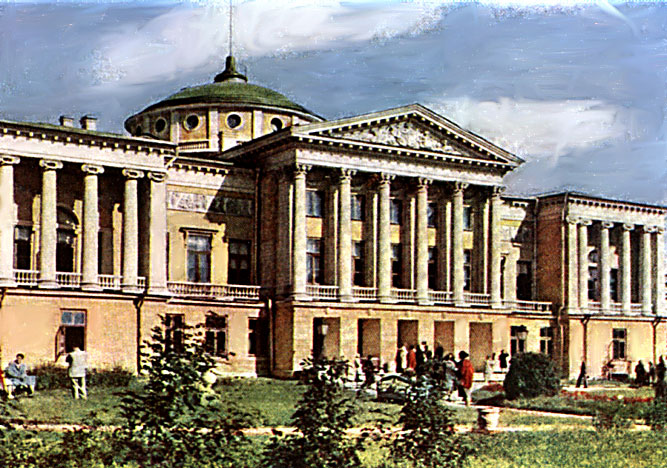| |
Annoyed by gossip about his beautiful
peasant wife, Count Nikolai Petrovich Sheremetev decided to leave Kuskovo and
look for privacy in the nearby village of Ostankino, where the Sheremetev
family had another estate. Here are views of Kuskovo. He inherited it from his mother, former
Princess Varvara Mikhailovna Cherkasskaia. As a young man the count showed
great interest in music, theater and the arts in general. When he decided to
build a new mansion at Ostankino, he had it in mind to have in it his own
theater, a library and halls for his collection of paintings. Sheremetev
consulted several architects, domestic and foreign, but, in the absence of
specific information, the question of who finally did design the wooden mansion
remains unanswered. Most often art historians speak of Guarenghi, Blanc,
Camporesi, Starov, Nazarov and even of Bazhenov, or conjecture that they all
contributed something toward the new home of Count Sheremetev, nicknamed
"Croesus, Junior" because of his enormous wealth. Guarenghi's
involvement in the planning of the mansion could be explained by the fact that
he had won first prize in the first architectural contest in Russia, and the
count would not miss the chance to have a winner design his new building. The
actual construction lasted quite a long time, from 1791 to 1799, and according
to documents was supervised by the count's own serf master-builder A. Mironov
and P. Argunov, the brother of the painter N. Argunov. The mansion was built in
a modified imitation of the style of luxurious Roman villas, locally known as
"Moscow classicism." Here also we see Ionic orders decorating the
facade and large dome on top of the central part of the building. Foreign
visitors mention the interior decoration, done with great care and taste, with
carved wood as main element. Vases, candelabra and even delicate chandeliers
that look as if they were made of bronze, are nothing but gilded carved wood.
Particular attention was paid to the decoration of the Theater Hall, located in
the center of the mansion. The count admired his beautiful actress-wife,
Praskovia Zhemchugova nee P. I. Kovaleva, and did not spare expense to please
her. Some of the best drama, ballet, opera and concert performances in Moscow
were given right in that hall. Shremetev had established a special school,
where Russian and foreign teachers trained his artists, singers and dancers.
Most of them were serfs, as was his wife; they received a complete education
that sometimes included a fair amount of French and Italian. Soviet art
historians usually exaggerate when they describe the life of these serf-artists
as miserable, and they neglect to say that they were offered an adequate
opportunity to develop their talents and in some instances were granted
freedom. Besides the count's wife, other famous serfs were the ballerina T. V.
Granatova (nee Shlikova) and the singer and musician S. A. Degtiarev, who was
freed and later became a well-known composer. The oratorio "Minin and
Pozharskii" was one of his best works. The huge garden around the mansion,
which included an artificial lake and woodland, was quite attractive. Beginning
with Paul, all Russian emperors visited Ostankino, and the list of dignitaries
included the Polish King Stanislas Ponintowski and King Wilhelm III of Prussia,
the father in law of Nicholas I. During the occupation of Moscow by Napoleon's
troops, marshal Ney lived in the mansion. After the revolution the estate was
expropriated and then neglected for years, restored in 1935-1946 and finally
turned into a museum.
To the south of the mansion is the Trinity Church, an interesting example of
the best in Moscow church architecture. It was built in 1678-1683, most
probably by the serf-builders of Prince N. A. Cherkaskii. The church has the
traditional kokoshniki and five cupolas, but it differs from others because of
its two chapels, one on each side, with special entrances and each crowned with
a single cupola. The elaborate brick construction is decorated with tiles and
white stone, which became very popular during the period of the Moscow baroque.
Here is the main facade. More illustrations are at
Interiors.
|
|


